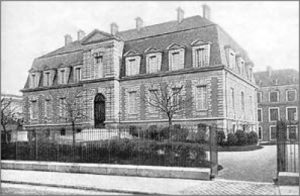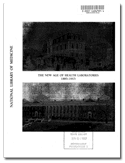Originally published in “The New Age of Health Laboratories 1885-1915” a brochure for an exhibit held in May-October 1987 by the U.S. National Library of Medicine.

Among the very first of the large health research institutes, and one that became a model for many others, was the institution built for and by Louis Pasteur in Paris. During the quarter-century prior to 1885, working much of the time in cramped laboratories at the Ecole Normale Superieure of Paris, Pasteur had earned the admiration of scientists everywhere with his investigations into crystallography and spontaneous generation; his applied researches bearing on the production of beer and wine and on the cultivation of silkworms; and his studies of the etiology and prevention of such animal diseases as anthrax, fowl cholera, and swine erysipelas. However, the great impetus to the creation of a Pasteur Institute came from Pasteur’s researches, late in his career, on rabies, culminating with the daring and successful inoculation in July 1885 of the Alsatian boy, Joseph Meister, against the disease. This initial inoculation almost immediately precipitated a flood of rabies victims descending upon Pasteur’s modest laboratory from all over Europe and the Americas in hope of obtaining treatment. News of these dramatic human and scientific developments was spread far and wide by a remarkable outpouring of stories, both in the popular press and in medical publications. While some of the accounts, both in France and abroad, were critical of Pasteur and the early inoculation processes, many others recognized the breakthrough that Pasteur had achieved. Most Frenchmen, for their part, still smarting from their crushing military defeat in the Franco-Prussian War of 1870, welcomed the discovery as a major boost to their national morale and prestige.
In the French Académie des Sciences, Pasteur’s friends quickly moved to create a French center for manufacturing the rabies vaccine and performing inoculations, an institution that would also include spacious facilities for Pasteur’s researches. In 1886 a committee organized a public subscription which rapidly attracted funds from all over France and many foreign countries. In 1887 a plot of land was purchased in Paris and construction on the first laboratory buildings was started. Finally in late 1888, the Pasteur institute was inaugurated in a ceremony attended by many scientists and dignitaries, headed by Mr. Sadi Carnot, President of France.
By the time his new Institute was ready for occupancy, Pasteur was tired, aging, and impaired by a second stroke. In his own words, he was a man “vanquished by time.” He managed to continue some of his researches on rabies and to defend his work against occasional detractors. However, much of his time was taken up with organizing the Institute and acknowledging the world’s plaudits. He died in 1895 and was eventually interred in an impressive crypt on the grounds of the Institute.
During the following years, up to World War I, the Pasteur Institute flourished in the aura of the great man’s name while nurturing and expanding on the research lines and interests he had started. Further physical growth quickly became necessary. Among the major early additions were the acquisition of extensive serum production facilities in the Paris suburbs, the building of a separate chemistry building in 1901 and, about the same time, the development and completion of a research hospital of 120 beds, primarily for infectious disease studies.
Meanwhile, continued scientific excellence was achieved, during that period and beyond, under two eminent directors, Emile Duclaux from 1895 to 1904 and Emile Roux from 1904 to 1933; both men had been close disciples and associates of Pasteur. Rous along with Alexandre Yersin, Louis Martin, and other disciples, in the early 1890s made the Institute one of the chief centers of research on the etiology of diphtheria and of the introduction and production of antitoxin against that disease. And as time went by, the Institute’s staff scientists launched equally important investigations of other diseases.
Apart from the regular staff, from an early date distinguished outside scientists were invited to use the facilities. As early as 1888 Pasteur himself made room for the Russian scientist Elie Metchnikoff as a laboratory chief. Remaining in Paris up until his death in 1916, the latter found the Institute to be a congenial site for much of his research into the mechanisms of immunology. Similarly, other “independent spirits” of science were offered facilities, including men of stature of the French military, physician Alphonse Laveran, who as early as 1880 had discovered the causative organism of malaria.
The Pasteur Institute became, along with Koch’s Institute in Berlin, one of the two principal early centers in the world for teaching the new techniques of microbiological research as well as for disseminating information about the modes of producing vaccines and sera. Formal classes in biochemistry (Duclaux) and microbiology (Roux) were begun early in 1889. They soon attracted students from numerous countries, while many other scientists came to the Institute for shorter periods of observation. At the same time, places as teaching or research assistants were found on the Institute staff for a succession of junior scientists, some of whom subsequently achieved great renown. Particularly prominent were several who ultimately left the parent Pasteur Institute to form or help staff similar laboratories or Pasteur institutes in other cities, among them Jules Bordet in Brussels, Albert Calmette in Saigon and later Lille, Charles Nicolle in Tunis, and Alexandre Yersin in Nhatrang and Hanoi.
Elsewhere, other important laboratories and health research institutes were being founded with the Pasteur Institute as a principal source of inspiration if not as an actual model. Among these, the Russian Institute for Experimental Medicien opened in St. Petersburg in 1890, the British Institute of Preventive Medicine (later changed to the Lister Institute) in 1891, and Shibasaburo Kitasato’s Institute for Infectious Diseases in Japan in 1892. In Germany, meanwhile, Robert Koch had made his great bacteriological contributions of the 1880s in the laboratories of the Imperial Health Office and the University of Berlin. Only in 1891 did he finally obtain his own magnificent facilities, the Institut fur Infectionskrankenheiten. Moreover, within a few years several of Koch’s outstanding students and assistants had become heads of institutes, prominent among them Kitasato, Emil von Behring and Paul Ehrlich.
Read entire brochure:
 Pasteur Brewing Louis Pasteur – Science, Health, and Brewing
Pasteur Brewing Louis Pasteur – Science, Health, and Brewing 